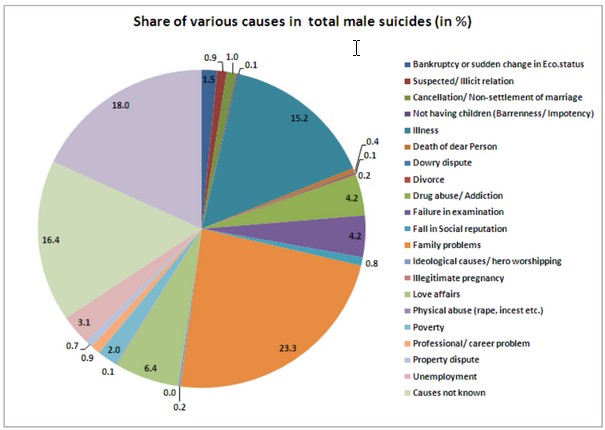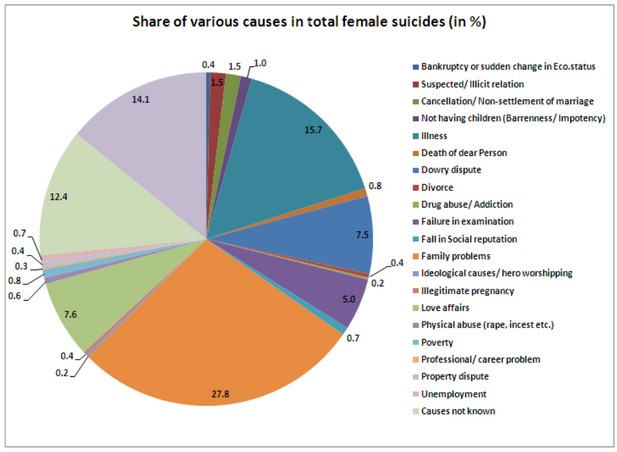Accidental Deaths and Suicides in India 2012 (ADSI 2012), a report produced by the National Crime Records Bureau (NCRB), provides 22 different causes behind suicides in the country. According to this report, family problems (25.6 per cent) and illness (20.8 per cent) accounted for a majority (46.4 per cent) of total suicides committed in India during 2012. Insanity/ mental illness accounted for 6.4 per cent of total suicide deaths.
ADSI 2012 notes that the country has witnessed 69 suicides per day due to illness, 11 suicides per day owing to love affairs, 6 suicides per day due to poverty, 6 suicides per day due to failure in examination, 5 suicides per day owing to unemployment and 5 suicides per day due to dowry dispute.
While identifying the incidence of suicides due to such specific triggers, the report also ranks states in order of the number of suicides reported due to a particular cause. Thus, for instance, it was found that suicides caused by poverty were mostly reported from Andhra Pradesh (1,096), Karnataka (364), Maharashtra (245) and Assam (219). In the 'so-called' industrialized states of Maharashtra (258) and Gujarat (224), suicides caused by unemployment were the highest.
Out of the 23,398 number of suicide deaths reported in 2012 among young males aged 15-29 years, most were caused by family problems (23.3 per cent). Unemployment and poverty accounted for 3.1 per cent and 2 per cent of suicidal deaths respectively.
Out of the 18,395 number of suicide deaths in 2012 among young females of the same age group, most were triggered by family problems (27.8 per cent). Poverty and unemployment each stood for less than one per cent of suicides in this group.
Aggregated statistics such as this made me curious: what are the definitions of poverty and unemployment used to arrive at these figures and how do the states actually ascertain the cause of suicides? Is there uniformity in the manner in which this is done? Accordingly, I filed an RTI enquiry on 10 October, 2013 with the CPIO, Ministry of Home Affairs, New Delhi asking them three questions.
-
What are the definitions of 'poverty' and 'unemployment' that have been used in NCRB's ADSI 2012 report?
-
Is the definition of 'poverty' used in ADSI 2012 report same as the definition of 'poverty' used by the Planning Commission to arrive at poverty figures in 2011-12?
-
Is the definition of 'unemployment' used in ADSI 2012 report same as the definition of 'unemployment' used by the National Sample Survey (NSS) to arrive at unemployment figures?
In the context of (2) and (3), I had also specifically pointed out that as per the Planning Commission, for rural areas the national poverty line using the Tendulkar methodology is estimated at Rs. 816 per capita per month (i.e. Rs. 27.2 per capita per day) and Rs. 1,000 per capita per month (i.e. Rs. 33.3 per capita per day) in urban areas.
According to the Key Indicators of Employment and Unemployment in India, 2011-12 (NSS 68th Round), Unemployment Rate (UR) is the ratio of number of unemployed persons/person-days to the number of persons/person-days in the labour force. Three sets of estimates of unemployment rates are obtained based on the estimates of unemployment obtained by three different approaches used for classification of the activity statuses of persons. The different estimates of unemployment are:
-
Number of persons usually unemployed based on 'usual status' approach,
-
Number of persons unemployed on an average in a week, based on the current weekly status (CWS) approach, and
-
Number of person-days unemployed on an average during the reference period of seven days preceding the date of survey, based on the current daily status (CDS) approach.
My query, which was received by the Ministry of Home Affairs was further forwarded to the concerned department, that is the NCRB in this case, on 15 October, 2013. The NCRB in its reply dated 11 November, 2013 (letter No. STT(200)/RTI-ADSI/325/13/NCRB) informed me that: "NCRB collects data on suicides in a prescribed format which contains 22 specified causes for committing suicides. Two causes namely poverty and unemployment are among the specified causes. NCRB has not defined any causes including poverty and unemployment in the format. The States are filling the figures in the format at their discretion." (Emphasis added) The NCRB also furnished the relevant portion of the format.
What does the NCRB's reply mean? The reply to my query from the NCRB clearly implies that the definition of 'poverty' as followed by the Planning Commission, and 'unemployment' as used by the National Sample Survey (under the Ministry of Statistics and Programme Implementation) deviate from that of the NCRB. If states have indeed been filling the forms at their discretion, it is only likely that the definitions of various causes of suicide deaths vary across the states.
This obviously raises the following question: How can these numbers under a certain classification (say 'poverty') then be added to arrive at a national level figure? The methodology of aggregation is seriously flawed.
It is also pertinent to mention here that some states, guided by the populism motive, may have been following their own definitions of 'poverty' while identifying below poverty line (BPL) households, which differ from the Planning Commission's definition. The same, however, cannot be said about 'unemployment'. But the fact that the NCRB itself does not have an inkling of the basis on which the states are providing statistics for "suicides due to unemployment" leaves a grey area around that as well.
In my RTI, I had deliberately confined myself to enquiring about the definitions of 'poverty' and 'unemployment' followed by the NCRB, since these are likely to have a definite scientific or statistical basis. The reply to the enquiry was therefore particularly perplexing. Had I asked about the definition of 'love affairs', such an answer would perhaps have been acceptable.
Secondly, it is undoubtedly difficult to differentiate one suicide from another, based on the causes as identified by the NCRB. For example, 'unemployment' may lead one to 'bankruptcy or sudden change in economic status', which can further trigger 'poverty'. Differentiating these three causes in the absence of a proper definition for each of these is a difficult task. To aggregate data across geographies in the absence of a standard or definition and arrive at authentic national data is even more impossible. It is really surprising that the NCRB has accomplished both with such ease.
In an earlier article for India Together, I had pointed to the significant variance between suicide data as published by the NCRB and in a study by leading medical journal The Lancet, titled "Suicide mortality in India: A nationally representative survey (2012)." In view of the present admissions by the NCRB in response to the RTI, it appears that the data presented by the Bureau should be opened up to more scrutiny.
References:
- Accidental Deaths and Suicides in India 2012, NCRB, http://ncrb.gov.in/
- Press Note on Poverty Estimates, 2011-12, Planning Commission, July, 2013
- Key Indicators of Employment and Unemployment in India, 2011-12 (NSS 68th Round)

























